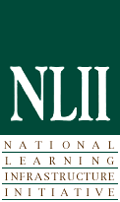

Deeper
Learning
Teaching
Practices
Design
Implications
Technology
Uses
Mapping
the Learning Space:
Learning Activities - An Overview of Possibilities
Active
learning happens whenever the student is engaged, involved and makes an
investment of time and energy in their learning. There may be as many
ways of involving students in discovery as there are disciplines, but
every discipline can borrow from and build on practices that allow the
student to examine and explore their understandings. From the perspective
of instructional design, it is important that the learning activity be
an outcome of specific learning goals. In medical education, case studies
are consistently used to teach students how to think diagnostically and
to understand and take responsibility for misinterpretations or acting
on incomplete data. In logic, problem-based learning allows the students
to apply their understandings and test abstract beliefs against real-world
scenarios. Many learning activities used in higher educationally physically
place the student into real-world environments, and ask them to navigate
their path, gather data, draw conclusions, make diverse choices.

Most meaningful to the student are the in situ environments where they learn by doing, in an environment that creates consequences. Field studies in the biologies, where students have been known to determine local pollutant levels, research local regulations and determine their team's final actions (including advocating for change) is experiential learning that students carry with them, discuss and use to make life-decisions on career and community involvement.
Apprenticeship in the arts, in the laboratory, and in business internships give students a sense of responsibility, place and meaning within subject and study. Students that search for relevance and responsibility in their education often find ways to stay in the apprentice environment long after the course or program ends.
Within the classroom, a number of learning activities can be utilized to create relevance where students might otherwise have difficulties making connection. History can be brought to life when combined with performance. The emotion and conflict embedded in the issues of the American civil war can be vibrantly brought to life when a class is asked to prepare for a performance, with each student given a role in the struggle: soldier, slave, woman left alone in a northern city, southern child hungry on a distant farm. Suddenly, age-old issues become emotionally-rich, passionate understandings.
A significant factor in engagement lies in the student's relationship with colleagues. Often, being asked to work in teams will illicit a sense of responsibility to time on task that the student would not have felt otherwise. Those not motivated by grade often feel (or are pressured by their fellow students to feel) a sense of responsibility in their role on the team. Motivation and time on task are strong factors in deeper learning.
Technology has contributed greatly to effective learning activities across the curriculum in the area of creation and critique. Students that create web pages documenting their final projects become excited and intrigued by the possibility of their work being seen by the world, instead of being read (along with other, better papers) only by their instructor. The web, a collection of diverse possibilities and ways of expressing, is a lure for student engagement and creation.
As students become more technically skilled, this creation possibility expands to CD-creation, digital video, multimedia projects using PowerPoint, Excel, Flash animation and unique ways for the student to express their understandings of the material and create personal reflections of what was learned.
Those wishing to explore resources and ideas on active learning might begin by visiting the National Teaching and Learning Forum site. Read Bonwell and Elison's article and branch out to free resources available through the NTLF library.
Active learning is possible, desirable, and with some thoughtful design, easily implemented across the curriculum.